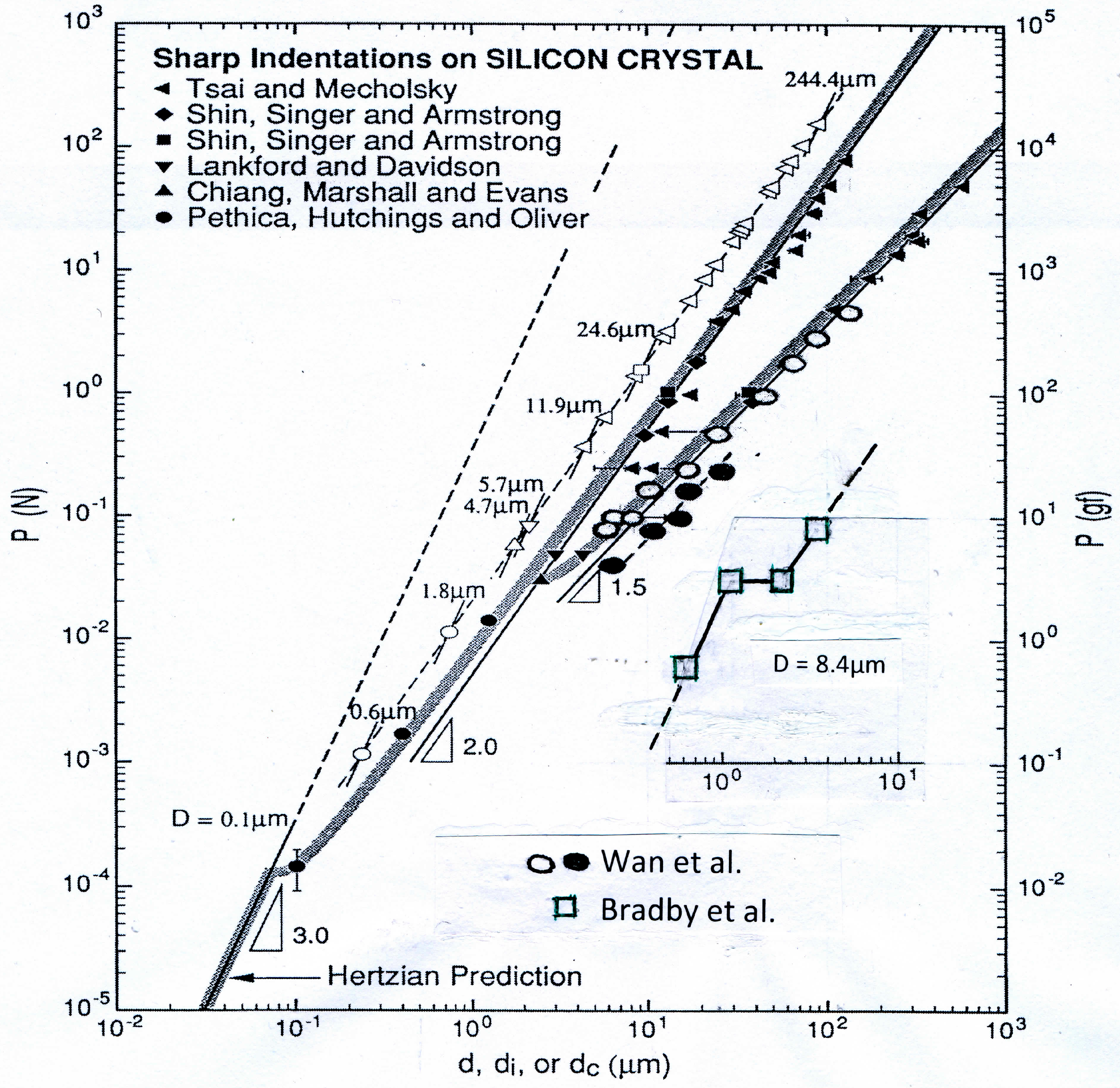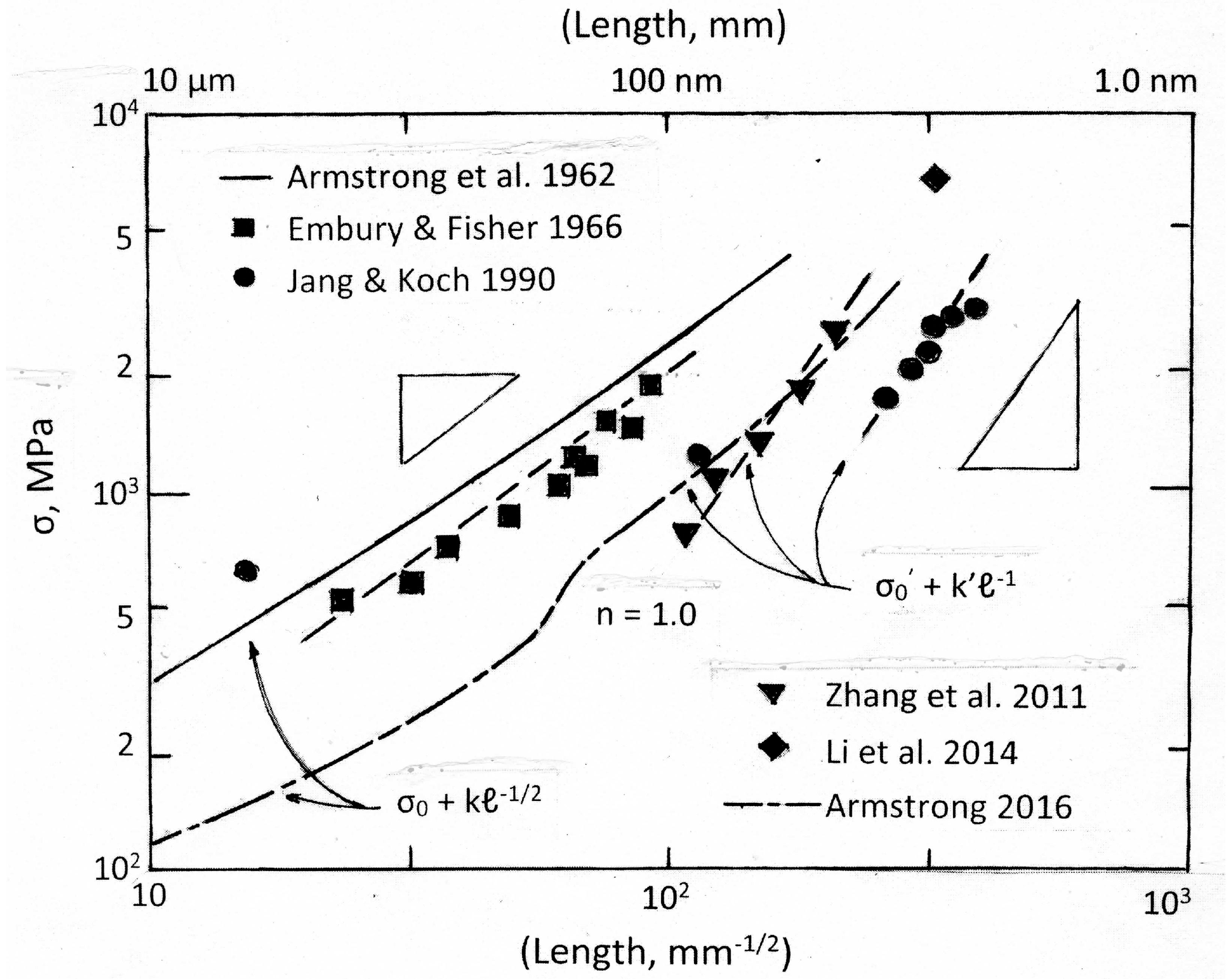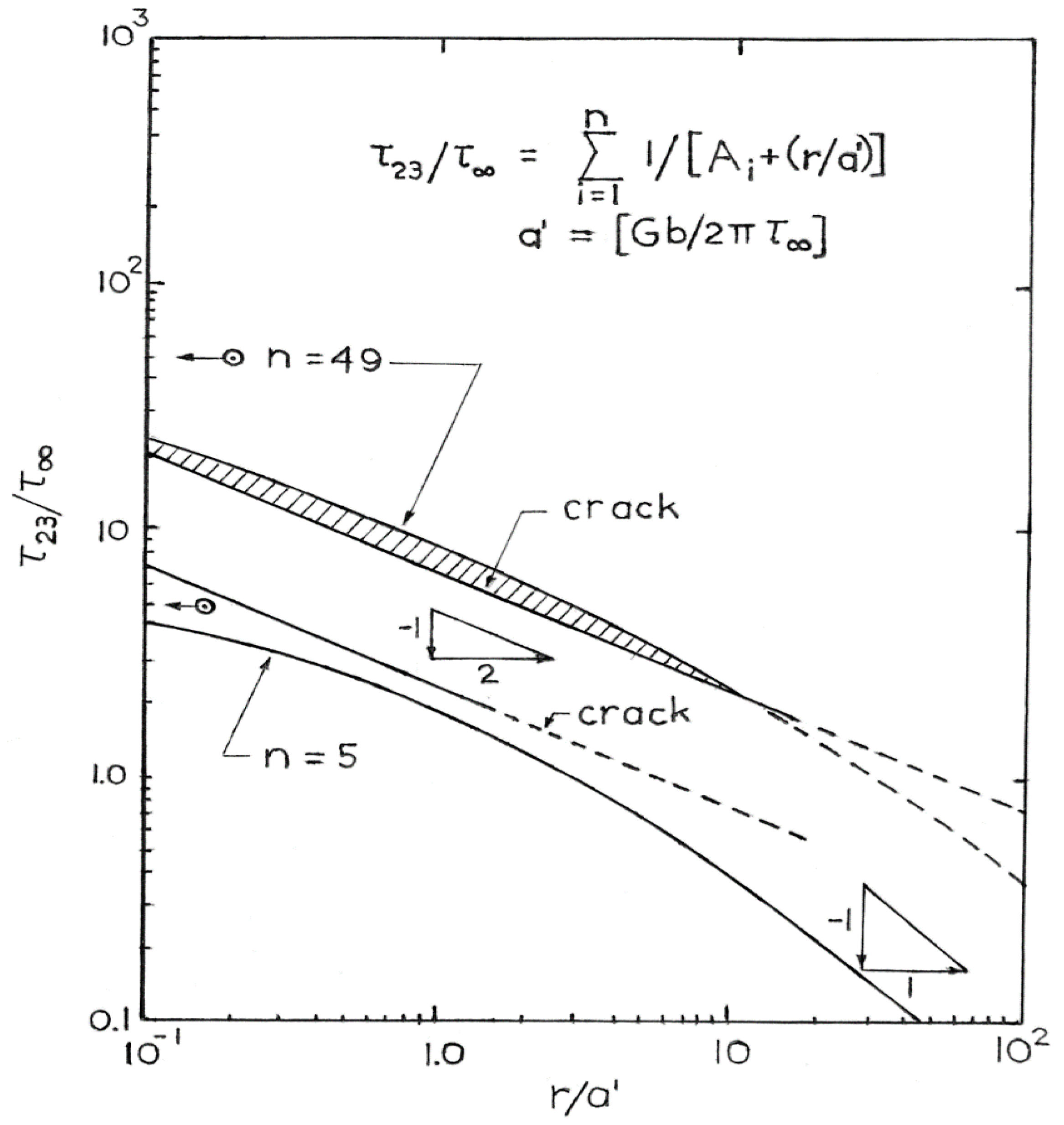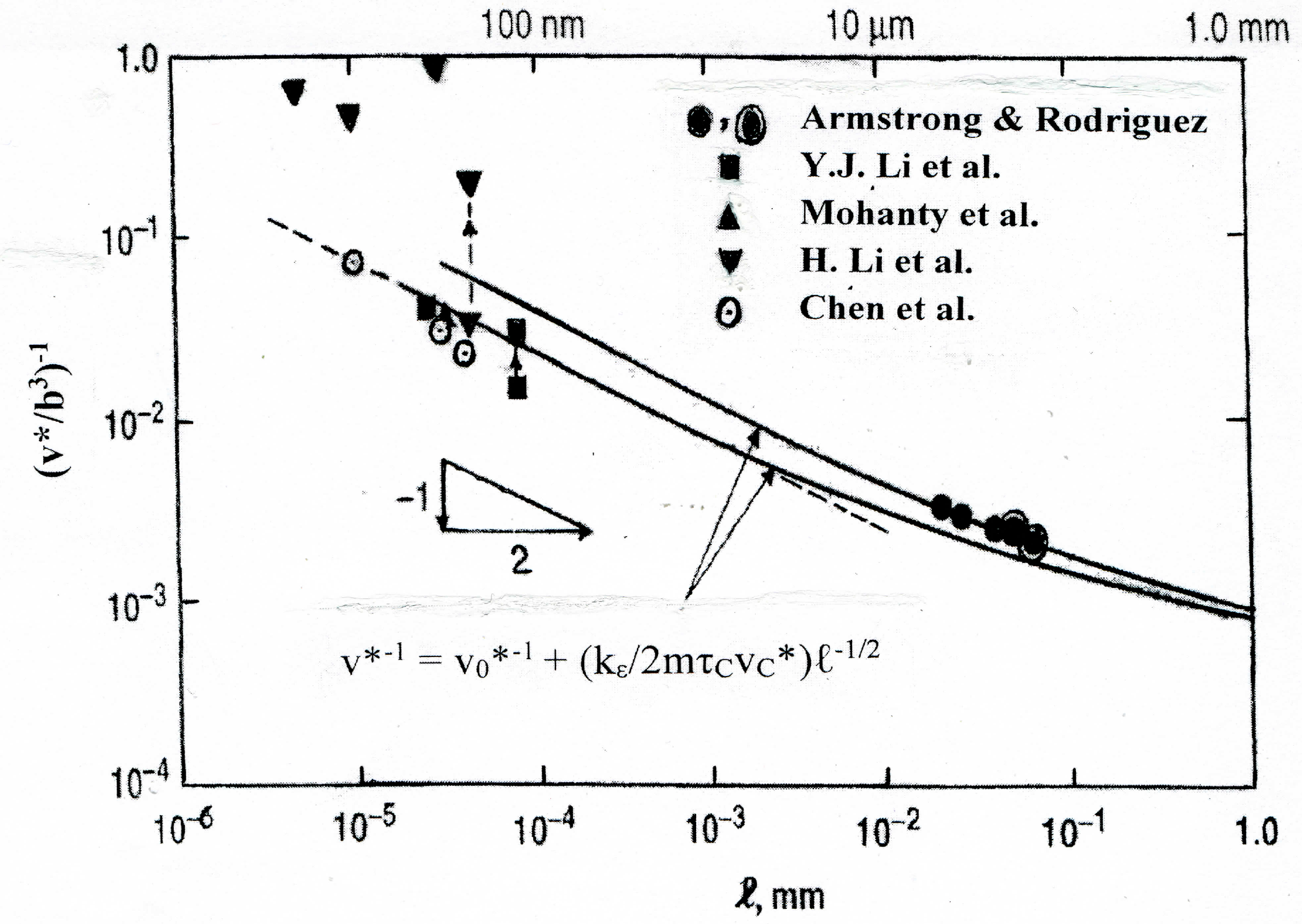Crystal Strengths at Micro- and Nano-Scale Dimensions
Abstract
1. Introduction
2. Elastic, Plastic, and Cracking Aspects of Crystal Nano-Indentations
3. Crystal (Grain) Size-Dependent Strengths
4. Crystal Dislocation Pile-Ups at Small Dimensions
5. Crystal Size-Dependent Strain Rate Sensitivity
6. Discussion
7. Summary
Author Contributions
Acknowledgments
Conflicts of Interest
References
- Vollertsen, F.; Biermann, D.; Hansen, H.N.; Jawahir, I.S.; Kuzman, K. Size effects in manufacturing of metallic components. CIRP Ann.–Manufact. Tech. 2009, 58, 566–587. [Google Scholar] [CrossRef]
- Asano, K.; Tang, H.; Chen, C.-Y.; Nagoshi, T.; Chang, T.-F.; Yamane, D.; Konishi, T.; Machida, K.; Masu, K.; Sone, M. Promoted bending strength in micro-cantilevers composed of nano-grained gold toward MEMS applications. Microelect. Eng. 2018, 196, 20–24. [Google Scholar] [CrossRef]
- Cheng, C.; Wan, M.; Meng, B.; Zhao, R.; Han, W.P. Size effect on the yield behavior of metal foil under multiaxial stress states: Experimental investigation and modelling. Int. J. Mech. Sci. 2019, 151, 760–771. [Google Scholar] [CrossRef]
- Zhang, L.; Zhao, H.; Dai, Y.; Yang, Y.; Du, X.; Tang, P.; Zhang, L. Molecular dynamics simulation of deformation accumulation in repeated nanometric cutting on single-crystal copper. RSC Adv. 2015, 5, 12678–12685. [Google Scholar] [CrossRef]
- Vorotilo, S.; Loginov, P.; Mishnaevsky, L.; Siderenko, D.; Levashov, E. Nano-engineering of metallic alloys for machining tools: Multiscale computational and in situ TEM investigation of mechanisms. Mater. Sci. Eng. A 2019, 739, 480–490. [Google Scholar] [CrossRef]
- Brenner, S.S. Properties of whiskers. In Growth and Perfection of Crystals; Doremus, R.H., Roberts, B.W., Turnbull, D., Eds.; John Wiley & Sons, Inc.: New York, NY, USA, 1958; pp. 157–190. [Google Scholar]
- Li, Y.; Raabe, D.; Herbig, M.; Choi, P.-P.; Goto, S.; Kostka, A.; Yarita, H.; Borchers, C.; Kirchheim, R. Segregation stabilizes nano-crystalline bulk steel with near theoretical strength. Phys. Rev. Lett. 2014, 113, 106104. [Google Scholar] [CrossRef]
- Rogne, B.R.S.; Thaulow, C. Strengthening mechanisms of iron micro-pillars. Philos. Mag. A 2015, 95, 1814–1828. [Google Scholar] [CrossRef]
- Wheeler, J.M.; Kirchlechner, C.; Micha, J.-S.; Michler, J.; Kiener, D. The effect of size on the strength of FCC metals at elevated temperatures: Annealed copper. Phil. Mag. 2016, 96, 3379–3395. [Google Scholar] [CrossRef]
- Armstrong, R.W.; Chou, Y.T.; Fisher, R.M.; Louat, N. The limiting grain size dependence of the strength of a polycrystalline aggregate. Phil. Mag. 1966, 14, 943–951. [Google Scholar] [CrossRef]
- Li, J.C.M.; Liu, G.C.T. Circular dislocation pile-ups: I. Strength of ultrafine polycrystalline aggregates. Phil. Mag. 1967, 15, 1059–1063. [Google Scholar] [CrossRef]
- Armstrong, R.W. Hall-Petch analysis for nano-polycrystals. In Nano-Metals—Status and Perspective; 33rd Risö International Symposium on Materials Science; Fæster, S., Hansen, N., Huang, X., Juul Jensen, D., Ralph, B., Eds.; Technical University of Denmark: Roskilde, Denmark, 2012; pp. 181–199. [Google Scholar]
- Hughes, G.D.; Smith, S.D.; Pande, C.S.; Johnson, H.R.; Armstrong, R.W. Hall-Petch strengthening for the micro-hardness of twelve nanometer grain diameter electrodeposited nickel. Scr. Metall. 1986, 20, 93–97. [Google Scholar] [CrossRef]
- Armstrong, R.W.; Mecholsky, J.J.; Shin, H.; Tsai, Y.L. Elasticity, plasticity and cracking at indentations in single crystal silicon. J. Mater. Sci. Letts. 1993, 12, 1274–1275. [Google Scholar] [CrossRef]
- Pethica, J.B.; Hutchings, R.; Oliver, W.R. Hardness measurement at penetration depths as small as 20 nm. Phil. Mag. 1983, 48, 593–606. [Google Scholar] [CrossRef]
- Wan, H.; Shen, Y.; Chen, Q.; Chen, Y. A plastic damage model for finite element analysis of cracking of silicon under indentation. J. Mater. Res. 2010, 25, 2226–2236. [Google Scholar] [CrossRef]
- Bradby, J.E.; Williams, J.S.; Wong-Leung, J.; Swain, M.V.; Munroe, P. Mechanical deformation in silicon by micro-indentation. J. Mater. Res. 2001, 16, 1500–1507. [Google Scholar] [CrossRef]
- Armstrong, R.W.; Elban, W.L. Exceptional crystal strain hardening determined over macro- to micro- to nano-size scales in continuous spherical indentation tests. Mater. Sci. Eng. A 2019, 757, 95–100. [Google Scholar] [CrossRef]
- Armstrong, R.W.; Elban, W.L. Tungsten (111) crystal strain hardening in nano-indentations. Int. J. Refract. Met. Hard Mater. 2020, 87, 105140. [Google Scholar] [CrossRef]
- Armstrong, R.W.; Elban, W.L. Dislocation reaction mechanism for enhanced strain hardening in crystal nano-indentations. Crystals 2020, 10, 9. [Google Scholar] [CrossRef]
- Yang, H.K.; Cao, K.; Han, Y.; Wen, M.; Guo, J.M.; Tan, Z.L.; Lu, J.; Lu, L. The combined effects of grain and sample sizes on the mechanical properties and fracture modes of gold micro-wires. J. Mater. Sci. Tech. 2019, 35, 76–83. [Google Scholar] [CrossRef]
- Guo, S.; He, Y.; Li, Z.; Lei, J.; Liu, D. Size and stress dependences in the tensile stress relaxation of thin copper wires at room temperature. Int. J. Plast. 2019, 112, 278–296. [Google Scholar] [CrossRef]
- Yuan, L.; Xu, C.; Shivpuri, R.; Shan, D.; Guo, B. Size effect in the uniaxial compression of polycrystalline Ni nanopillars with small number of grains. Metall. Mater. Trans. A 2019, 50A, 4462–4479. [Google Scholar] [CrossRef]
- Shahbeyk, S.; Voyiadjis, G.Z.; Habibi, V.; Astaneh, S.H.; Yaghoobi, M. Review of size effects during micro-pillar compression test: Experiments and atomistic simulations. Crystals 2019, 9, 591. [Google Scholar] [CrossRef]
- Kiener, D.; Fritz, R.; Alfreider, M.; Leitner, A.; Pippan, R.; Maier-Kiener, V. Rate limiting deformation mechanisms of bcc metals in confined volumes. Acta Mater. 2019, 166, 687–701. [Google Scholar] [CrossRef]
- Armstrong, R.W. Crystal engineering for mechanical strength at nano-scale dimensions. Crystals 2017, 7, 315. [Google Scholar] [CrossRef]
- Armstrong, R.W.; Smith, T.R. Dislocation pile-up predictions for the strength properties of ultrafine grain size fcc metals. In Processing and Properties of Nanocrystalline Materials; Suryanarayana, C., Singh, J., Froes, F.H., Eds.; TMS-AIME: Warrendale, PA, USA, 1996; pp. 345–354. [Google Scholar]
- Petch, N.J. The cleavage strength of polycrystals. J. Iron Steel Inst. 1953, 174, 25–28. [Google Scholar]
- Stroh, A.N. The formation of cracks as a result of plastic flow. Proc. R. Soc. (Lond.) A 1954, 223, 404–414. [Google Scholar]
- Armstrong, R.W. Material grain size and crack size influences on cleavage fracturing. Phil. Trans. R. Soc. (Lond.) A 2015, 373, 20140124. [Google Scholar] [CrossRef]
- Hohenwarter, A.; Pippan, R. Anisotropic fracture behavior of ultrafine-grain iron. Mater. Sci. Eng. A 2010, 527, 2649–2656. [Google Scholar] [CrossRef]
- Prasad, Y.V.R.K.; Armstrong, R.W. Polycrystal versus single-crystal strain rate sensitivity of cadmium. Phil. Mag. 1974, 29, 1421–1425. [Google Scholar] [CrossRef]
- Armstrong, R.W.; Rodriguez, P. Flow stress/strain rate/grain size coupling for fcc nano-polycrystals. Phil. Mag. 2006, 86, 5787–5796. [Google Scholar] [CrossRef]
- Armstrong, R.W. Size effects on material yield strength/deformation/fracturing properties. J. Mater. Sci. 2019, 1–16. [Google Scholar] [CrossRef]
- Chen, J.; Lu, L.; Lu, K. Hardness and strain rate sensitivity of nano-crystalline Cu. Scr. Mater. 2006, 54, 1913–1918. [Google Scholar] [CrossRef]
- Zhou, X.; Li, X.Y.; Lu, K. Enhanced thermal stability of nano-grained metals below a critical grain size. Science 2018, 360, 526–530. [Google Scholar] [CrossRef] [PubMed]
- Armstrong, R.W.; Conrad, H.; Nabarro, F.R.N. Meso-to-nano-scopic polycrystal/composite strengthening. In Mechanical Properties of Nano-Structured Materials and Nano-Composites; Ovid’ko, I., Pande, C.S., Krishnamoorti, R., Lavernia, E., Skandan, G., Eds.; Mater. Res. Soc.: Warrendale, PA, USA, 2004; pp. 69–77. [Google Scholar]
- Filippov, P.; Koch, U. Nano-indentation of aluminum single crystals: Experimental study on influencing factors. Materials 2019, 12, 3688. [Google Scholar] [CrossRef] [PubMed]
- Ono, K. Size effects of high strength steel wires. Metals 2019, 9, 240. [Google Scholar] [CrossRef]
- Nowak, J.D.; Beaber, A.R.; Ugurlu, O.; Girshick, S.L.; Gerberich, W.W. Small size strength dependence on dislocation nucleation. Scr. Mater. 2010, 62, 819–822. [Google Scholar] [CrossRef]
- Hou, X.D.; Krauss, S.; Merle, B. Additional strengthening in length-scaled architectured copper with ultrafine and coarse domains. Scr. Mater. 2019, 165, 55–59. [Google Scholar] [CrossRef]
- Yan, S.; Zhou, H.; Qin, Q.H. Microstructure versus size: Nano/micro-scale deformation of solute-strengthening Al alloys via pillar compression tests. Mater. Res. Lett. 2019, 7, 53–59. [Google Scholar] [CrossRef]
- Kheradmand, N.; Rogne, B.R.; Dumoulin, S.; Deng, Y.; Johnsen, R.; Barnoush, A. Small scale testing approach to reveal specific features of slip behavior in bcc metals. Acta Mater. 2019, 174, 142–152. [Google Scholar] [CrossRef]
- Dong, J.L.; Wang, Z.; Han, L.N.; Tang, Y.L.; Qiao, J.W.; Shi, X.H.; Wang, Z.H. Novel in-situ Ti-based dendrite/nano-structured matrix composites with excellent mechanical performances upon dynamic compression. J. Alloy Compounds 2019, 781, 716–722. [Google Scholar] [CrossRef]
- Hansen, L.N.; David, E.C.; Brantut, N.; Wallis, D. Insight into the micro-physics of antigorite deformation from spherical nano-indentation. Phil. Trans. R. Soc. (Lond.) A 2020, 378, 20190197. [Google Scholar]
- Han, W.-Z.; Huang, L.; Ogata, S.; Kimizuka, H.; Yang, Z.-C.; Weinberger, C.; Li, Q.-J.; Liu, B.-Y.; Zhang, X.X.; Li, J.; et al. From “Smaller is stronger” to “Size-independent strength plateau”: Towards measuring the ideal strength of iron. Adv. Mater. 2015, 27, 3385–3390. [Google Scholar] [CrossRef] [PubMed]



© 2020 by the authors. Licensee MDPI, Basel, Switzerland. This article is an open access article distributed under the terms and conditions of the Creative Commons Attribution (CC BY) license (http://creativecommons.org/licenses/by/4.0/).
Share and Cite
Armstrong, R.W.; Elban, W.L. Crystal Strengths at Micro- and Nano-Scale Dimensions. Crystals 2020, 10, 88. https://doi.org/10.3390/cryst10020088
Armstrong RW, Elban WL. Crystal Strengths at Micro- and Nano-Scale Dimensions. Crystals. 2020; 10(2):88. https://doi.org/10.3390/cryst10020088
Chicago/Turabian StyleArmstrong, Ronald W., and Wayne L. Elban. 2020. "Crystal Strengths at Micro- and Nano-Scale Dimensions" Crystals 10, no. 2: 88. https://doi.org/10.3390/cryst10020088
APA StyleArmstrong, R. W., & Elban, W. L. (2020). Crystal Strengths at Micro- and Nano-Scale Dimensions. Crystals, 10(2), 88. https://doi.org/10.3390/cryst10020088






